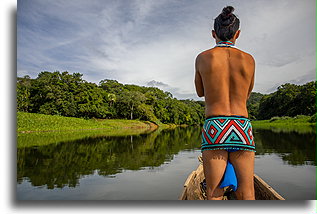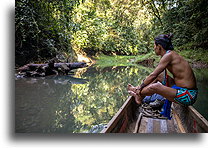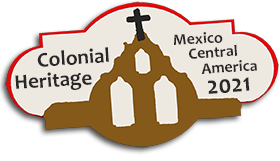Visit to the Indian Village
November 10
The night passed quickly in the terrible resort. Most importantly, we were only an hour drive from Puerto Corotú, a riverbank with boats departing to the Embera villages. As always, we did not want to go with the tour operator and it was a good choice. We left in no time with only three other people in our boat.



Emberá, which translates to "people", refers to one of the tribes of the indigenous peoples of Panama and Colombia. in the mid-twentieth century, some families migrated here in search of better hunting and fishing grounds, and in search of new space for agriculture. When in 1984 the government of Panama created Chagres National Park, the indigenous villages found themselves within its boundaries. The National Park has imposed restrictions on agricultural practices. The Indians were forced to live in group communities organized around primary schools, where to this day teaching is only in Spanish. This was in contradiction to their traditional, dispersed model of family settlements. All the imposed changes limited their sources of income and livelihoods. In 1996, in response to changes, the Embera communities began accepting tourists.



A motorized cuyaco, a long dugout canoe, took us up the river. We moved to the virgin world of the tropical forest. A journey through the meandering Chagres River with its lush vegetation along the banks was like a voyage of discoverers into the unknown. We stopped by a small creek, to have short walk to the waterfall. We walked barefoot imitating the Indian guides. Our incompetence and the pain of walking on sharp rocks in the river made us realize how far modern man is from the once basic elements of survival in the forest.



In Emberá Druá, which translates as "the village of the Embera people", we were greeted with the music of drums and flutes. The village consists of single-room stilt houses with thatched roofs and bark floors. The center of the village contains communal area, a primary school and a telephone box. The latter two and the Evangelical church located on a nearby hill were built of modern materials. They are in contrast to the surrounding traditional buildings. During our stay, the pastor was absent, apparently, he was visiting other villages.



During the entire visit, we were accompanied by a group of residents. On days when tourists arrive, Embera women wear parumas (colorful skirts). Their tops are often decorated with quarter dollar coins. The men are dressed in taparabo (colorful loincloths) and colorful beading. The bodies are covered with non-permanent jagua tattoos. The villagers treat tourists with enthusiasm. They were eager to talk about their traditions, social structure and everyday life. Before we left, we were served lunch prepared over an open fire. It contained fried local tilapia and plantain, all wrapped in a palm leaf.



Visiting Embera Drua was a very nice experience, mainly because their village is authentic. Unlike many indigenous groups around the world, the Emera Indians do not travel to a faux village to dance there. They invite tourists to their place and proudly share their authentic culture.


This time we had no problems with finding a place for a night. We got to Shelter Bay Marina on the Caribbean Sea coast. It is a typical yacht marina located at the entrance to the Panama Canal. Overlanders are also welcome there. Great and peaceful waterfront, good restaurant, we needed nothing more to be happy.









